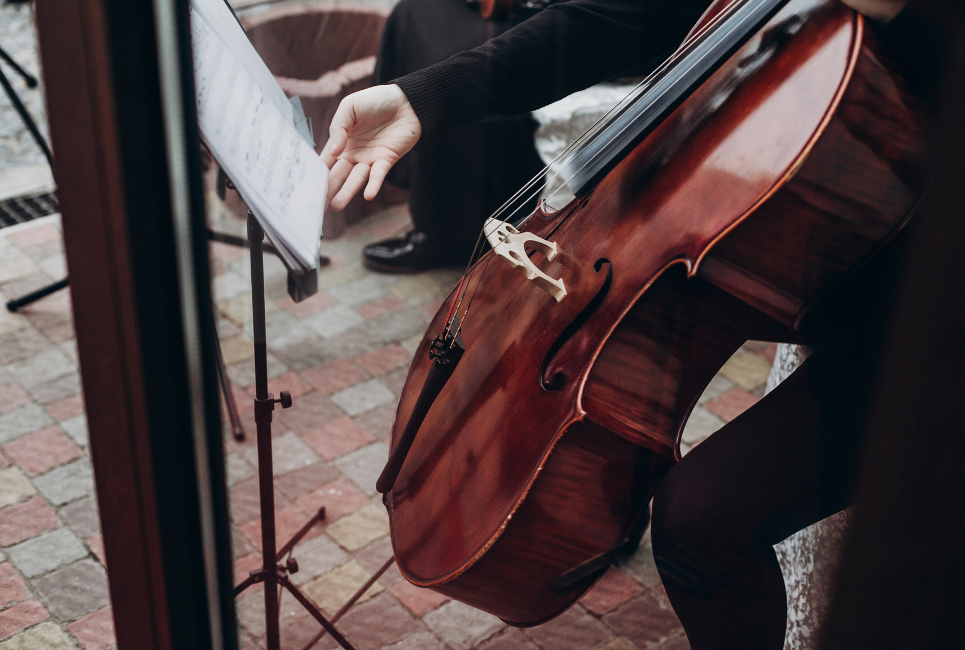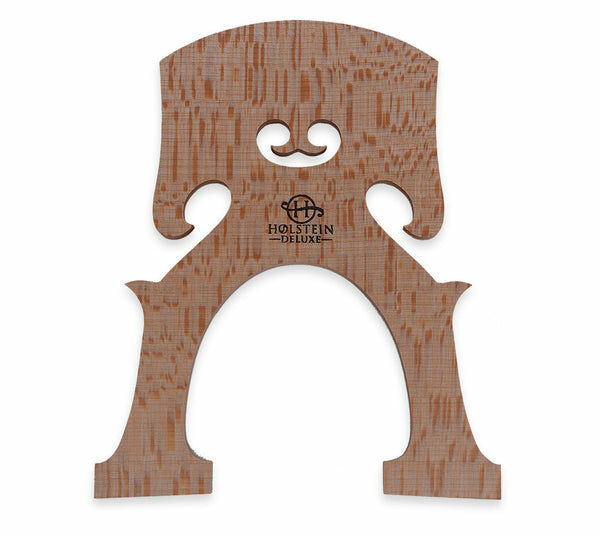- How to Find the Best 5 String Violins - April 21, 2022
- How to Hold a Violin Bow - April 21, 2022
- How to Hold a Cello Bow - April 17, 2022
When you buy an item using one of our links, we may earn a portion of the sale. Strings Guide and some products featured on the site are owned by the same company. Learn More.
Summary: Knowing how to find the best cello bridge means knowing suitable materials and customizing the cello bridge to fit your instrument.
People invest a great deal of time and effort finding the best cello, but not as many people worry about (or even think about) the best cello bridge until it breaks. What is the cello bridge, and how does it work? The bridge is a structurally important part of your cello or any other stringed instrument.
What Is the Cello Bridge?
If you hold your cello and look at it, you will see a small wooden piece that lifts the strings near the center of the cello. This piece is the bridge. Without it, your strings would lay across the cello and not be able to confer the vibrations into the instrument’s body.
Just like a bridge you drive over to get from one city to another, the bridge on your instrument moves the data along the strings into the body of the cello. This data is the vibrations of the strings, your bow movement across the strings, and so forth. Think of this data as the car that has to drive over the bridge. Once over, the vibrations get converted into the body of your instrument, amplified, and projected toward your audience.
Knowing how to find the best cello bridge can help you make the most out of this amplification and data transfer.
The Best Cello Bridge for Different Levels
Many cello pieces differ based on your level of musical talent and skill, for example, the type of hair used in your cello bow or the string material used in your cello strings. There is not nearly as much difference between skill levels with the bridge.
The difference between skill levels has more to do with what cello bridge problems you can fix on your own:
- Beginner: You should have all cello bridge repairs and replacements done by a professional only if you see something is broken.
- Intermediate: You should have most repairs and replacements done by a professional when you see something is broken, cracked, or leaning. At this stage, if you invest in a new cello, the standard cello bridge might not be the material or design you want, in which case you can have it replaced with another one you can custom order.
- Advanced: You can make minor adjustments when your cello bridge is leaning to one side and consider replacing the cello bridge to get something thinner that fits your instrument better.
Can I change or repair my cello bridge?
I would not recommend it in most cases. The height of your bridge makes a huge difference. Even ½ millimeter of height difference will be felt when you play. This changes the sound of your cello too. If you change things yourself without the right tools, you will not be able to change the height or sand the feet ever so slightly. I promise you that having a professional make repairs or replacements is worth it.
I have a woodworking shop in my home with a pretty experienced partner to help with all sanding and filing issues. However, this was a delicate and unique task. Even trying to do it with all the tools I have was stressful and difficult. In the end, I think I made things worse and ended up having to take it to a professional anyway–only this time, I paid for them to fix the damage I did and replace my cello bridge.
How to Find the Best Cello Bridge
When looking for the best cello bridge, you mainly want to look at material and quality. When you order a new cello bridge, even if you plan to have professionals install it, what you receive is not the finished product. What comes in the mail or at a music store is a standard, unfitted cut of wood that must be finished once it makes contact with your cello.
Material
Almost all cello bridges are maple. You might see a more specific material listed like “Bosnian Maple.” You might also see something listed as having “anti-corrosion” layers applied to the exterior of the maple. Replacement parts and original parts are almost always maples because the bridge has to be a strong enough hardwood to withstand the tension of the cello strings and bow movements.
Thickness
The thickness of the cello bridge you have on your instrument is essential. It also impacts the sound your cello and cello strings produce.
In this video, you can hear the sounds a cello makes with different thicknesses for the cello bridge:
Note: Most beginner cellos you buy for children or adults have very thick cello bridges, which are not conducive to the best sound quality. If you can, you might consider replacing the bridge that comes with your instrument with something thinner.
Height
The height of the best cello bridge must match the cello size you have. An appropriately sized bridge for a ¾ size cello will not fit a ½ size cello, or full-size cello just the same as a full size will not fit a ¾ instrument. The table below shows the average height for different cellos:
| Cello Size | Cello bridge height at the center |
| ½ cello | 3 inches |
| ¾ cello | 3.28 inches |
| 4/4 cello | 3.56 inches |
Fitted v. Unfitted
When you order a replacement cello bridge, you might see the word “unfitted” next to the bridge. That means the cello bridge is a standard product, unfitted to your instrument or any other instrument.
This is important because you won’t find a fitted product on the market. If a bridge is advertised as fitted, reconsider your purchase. Fitted means the bridge has been custom fitted to your instrument.
This is a complicated process that requires matching the height to your strings, adjusting the thickness and position to your fingerboard, and affixing the feet flush with your cello.
However, if you purchase a new cello that states that the bridge is fitted, it means that the process has already been completed. When the instrument arrives at your home, it will have the bridge in place, perfectly positioned, and ready to play.
Used or Rented
Be advised that if you are buying a used cello or using a rented cello, the bridge is one of the things you should examine before you accept an instrument. When cellos are improperly stored, the bridge can easily be damaged.
Learning how to take care of a cello (something I will go over further in the article) will give you the tools and expertise to evaluate the condition of the existing bridge on a used or rented cello and decide if you should repair it before you start playing.
Should I Replace or Repair a Cello Bridge?
The difference in cost between repairing or replacing a cello bridge can be a few hundred dollars, so it makes sense that you should fix where you can.
Warping
If you look at your cello (or a rental) and see that the bridge is warped, this is a wobbler, meaning it can be a repair or replacement. It depends entirely on how bad the warping is. The bridge should always be a straight line, cutting right across the center of your cello. If the warping is slight, a professional might be able to treat the wood and bend it back into place. This is akin to a sprained ankle: it will fix it, but it might not feel exactly the same.
If, on the other hand, there was significant damage from transportation, storage, or weather and the warping makes your bridge look like a wavy S, then you will likely need to replace it with the best cello bridge replacement you can find.
Cracks, Splinters, or Breaks
Cracks can happen too. This is when the wood has a crack, like a damaged windshield. A severe break might start as a crack and, left untreated, become a splinter through the body of the bridge. This is caused by many things (in my case, one of my children falling and landing on my cello). No matter the cause, it should be replaced.
Feet Lifting
Like warping, if the feet are lifting, it is probably a repair and not a replacement, so long as there is no other damage with the feet lifting. If this happens, it generally means you need a professional to use an adhesive to get the feet back in place.
In any situation, repairs and replacements are almost always better done by a professional. A luthier will use specific tools and techniques to repair or replace cello parts. Paying once to get a lifetime of use out of your best cello bridge is a good investment over accidentally damaging your instrument trying to repair it at home.
How to Care for the Best Cello Bridge
Taking care of your cello bridge will help it last longer, just as taking care of your cello will help it too. Cello bridge maintenance is easy:
When you practice, take a minute to examine your bridge from time to time. Look at it from the tailpiece side to see if it is standing perfectly upright rather than leaning one way or the other.
Note: It naturally pulls a bit on the bridge when you tighten your strings. The bridge is usually made of maple, which is strong enough to withstand that tension; however, it might cause the bridge to lean slightly after years of play.
Check the feet too. They should be flush with your cello. With time, the pulling and tension can yank the feet up and off the cello body.
Cello Bridges
If you buy a bridge online, remember that it will still need to be hand-shaped and adjusted to your instrument. This is best left to a professional or a hobbyist who is learning. The shape and curve of your bridge are critical to achieving the correct string height and playability. I chose these bridges based on their reviews and availability.
Glaesel Self Adjusting
The Glaesel Self Adjusting bridge is meant to bypass the need for a luthier by using adjustable feet and an already carved bridge. This may work for a student instrument, but I’d still recommend taking this bridge to be perfectly fitted to your cello. This bridge is available in high, medium, or low string heights for customizability.
The Glaesel Self Adjusting is a few that isn’t supposed to require further adjustment. While its options for multiple heights do add to the customizability, it will still need some adjustments from a luthier for optimal playability. It’s a great choice if you are a hobby builder and want to experiment a little bit. However, it’s a little too expensive to use as a temporary replacement.
Pros
- Not quite a blank slate bridge, may not require as much adjustment
- Available in multiple string heights for different playing levels and cellos
- Won’t allow for the best tone if not custom fit
Cons
- It is on the thicker side may require sanding
- I can’t find a mention of the bridge heights
- You risk getting a bridge that won’t work because of a lack of details.
- Unreturnable
Cremona VP-204C
Cremona makes both instruments and their fitting materials. Unlike the Glaesel, this bridge will need a significant amount of adjustment. It comes completely unshaped and will need to be angled and notched for your cello strings. This bridge is made from aged maple and, unlike many cheaper bridges, is made in Germany, not China.
Pros
- Made from premium aged maple a step up from their other bridges
- Inexpensive
- Comes ready for final adjustment and fitting
Cons
- Only available in full size
Holstein Deluxe
The Holestine Deluxe bridge is the most expensive bridge you can get from Fiddlershop’s line. These bridges are featured on most of the instruments sold in their store. Its made from maple sourced at a high altitude in Bosnia and Herzegovina. Like most bridges, this is unfinished and requires final adjustments by an experienced hand. It’s also relatively expensive, but the price reflects the quality of the wood and craftsmanship.
Pros
- Comes in two heights, 90 and 92mm
- Perfect for an advanced or professional cello
- The brand offers different models for different budgets
Cons
- Very Expensive for the deluxe model
String Centre Aubert
The String Centre Aubert is similar to the Glaesel in that it uses adjustable feet and comes notched for strings. Still, this won’t replace a well-adjusted bridge from a luthier. This bridge is supposed to be offered various heights, but I struggled to track others down. However, I’m sure they are out there. Additionally, bridges like these often have thicker wood. Since it’s cheap, it could be a great option as a temporary replacement for a few weeks, but if you plan to use it long-term, make sure its properly shaped so you can play comfortable.
Pros
- Adjustable feet
- Could potentially fit a cello as is
- Thicker wood
Cons
- Marketed as a bridge that doesn’t need adjusting when it likely will
- Hard to find in all sizes or other heights
Teller Bridge
Teller Bridges are made in Germany and found on various cellos. Similar to the Holestine bridges, these are made out of Bosnian maple. If ordered from the manufacturer directly, you can request custom height bridges, but they come in the standard 90 and 92mm. You will need to have this bridge custom fit to your cello.
Pros
- Affordable student bridge
- Made of quality wood
- Well know maker
- Available in custom heights
Cons
- Hard to find cello bridges on Amazon
FAQ
Answer: The cost for a cello bridge on its own is between $25 and $220, depending on the material and size. Once you buy a cello bridge, you also have to factor in the cost of replacements. This will cost between $50 and $100 for labor, depending on where you live. If your current cello bridge is damaged slightly or just leaning to one side, you might not need a replacement but a repair. That does not require a new bridge but will still cost about $35 for labor.
Answer: The best cello bridge should last a lifetime. If you, for example, get an antique or second-hand cello, as long as you take care of the instrument, the bridge should be in good condition. Taking care of an instrument will increase the lifespan of the cello bridge. If, however, you see the legs splaying, or the feet lifting off the cello, or a crack or significant warp in the wood, then you need a new cello bridge.
Answer: The size is based on the instrument and manufacturer. As mentioned, beginner models might come with thick cello bridges, while advanced (and more expensive) cello bridges are thinner. They are usually around 4 inches wide, a millimeter thick, and between 3 and 4 inches tall at the center.
Answer: Just as weather and humidity in the air affect your cello strings, it will affect the cello bridge. If you regularly go from hot to cold environments or in a high humidity area, this is something to worry about. You can always circumvent this issue by storing your cello in a hardshell case with a humidity monitor built inside. This will keep the cello strings and bridge (and all the other parts) safe from rapid temperature fluctuations.
Bottomline
The bottom line is that knowing how to find the best cello bridge means knowing the size cello you play with and what materials you want in the bridge. The right bridge will make it easy for you to play your instrument, and if you take care of it and check for signs of wear and tear, you can repair your cello bridge long before you have to replace it.
Looking for more interesting readings? Check out:








